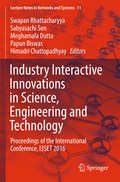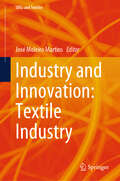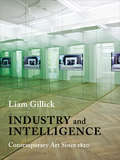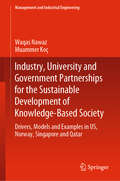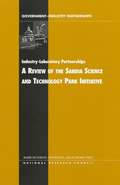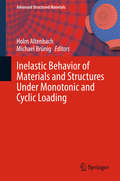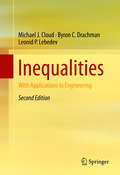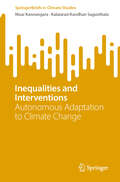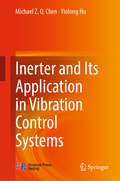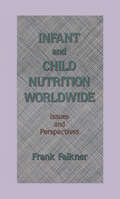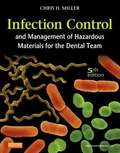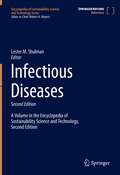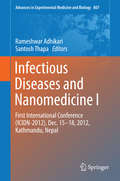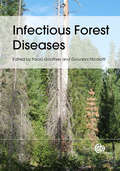- Table View
- List View
Industry Interactive Innovations in Science, Engineering and Technology
by Papun Biswas Swapan Bhattacharyya Sabyasachi Sen Meghamala Dutta Himadri ChattopadhyayThe book is a collection of peer-reviewed scientific papers submitted by active researchers in the International Conference on Industry Interactive Innovation in Science, Engineering and Technology (I3SET 2016). The conference is a collective initiative of all departments and disciplines of JIS College of Engineering (an autonomous institution), Kalyani, West Bengal, India. The primary objective of the conference is to strengthen interdisciplinary research and encourage innovation in a demand-driven way as desired by the industry for escalating technology for mankind. A galaxy of academicians, professionals, scientists, industry people and researchers from different parts of the country and abroad shared and contributed their knowledge. The major areas of I3SET 2016 include nonconventional energy and advanced power systems; nanotechnology and applications; pattern recognition and machine intelligence; digital signal and image processing; modern instrumentation, control, robotics and automation; civil engineering and structural design; real-time and embedded systems, communication and devices; advanced optimization techniques; biotechnology, biomedical instrumentation and bioinformatics; and outcome based education.
Industry Self-Regulation and Voluntary Environmental Compliance
by Jr., Al IannuzziWhy self-regulation? With the advent of such concepts as design for the environment, industrial ecology, and the recognized enlightened self-interest that voluntary compliance brings, it is in any company's best interest to avoid fines, liabilities, and bad publicity. Consumer concern and pressure from the marketplace give a competitive advantage t
Industry X.0: Realizing Digital Value in Industrial Sectors
by Eric SchaefferIndustry X.0 takes an insightful look at the business impact of the Internet of Things movement on the industrial sphere. Eric Schaeffer combines deep analysis with practical strategic guidance, and offers tangible and actionable recommendations on how to realise value in the current digital age. Based on extensive research and insights into the six core competencies that have been identified by Accenture, Industry X.0 explores critical aspects of the Industrial Internet of Things (IIoT), discussing and defining them in an engaging and accessible manner. These include managing smart data, handling digital product development, skilling up the workforce, mastering innovation, making the most of platforms and ecosystems, and much more. Meticulously researched and clearly explained, Industry X.0 makes a stringent case for companies to actively shift mind-sets away from products, towards services, value and outcomes. Complemented by a wealth of case studies and real world examples, this book provides invaluable, practical 'how-to' advice for business organizations as they embark on their journeys into the era of the IIoT.
Industry and Innovation: Textile Industry (SDGs and Textiles)
by José Moleiro MartinsThe primary objective of this book is to offer readers an insightful exploration into the realms of innovation and sustainability within the textile industry. As global competition intensifies, organizations are increasingly compelled to revisit and refine their business strategies, emphasizing the imperative for continuous innovation and adaptability. This shift towards innovation-centric strategies is driven by the pursuit of sustainability and a competitive advantage, underscoring innovation as the cornerstone for business growth and market expansion. Innovation not only opens avenues for companies to overhaul their business models and enhance process technologies but also enables them to achieve optimal productivity and minimize waste. In an era characterized by swift technological advancements, the demand for rapid information flow, and evolving consumer preferences, a firm’s capability to innovate emerges as a critical determinant of its growth, sustainability, and competitive positioning in the textile sector. Process innovation, which entails the adoption of novel or significantly improved manufacturing or delivery methodologies, plays a pivotal role. This could involve substantial modifications in techniques, equipment, and/or software, aimed at bolstering production efficiency, augmenting quality, or facilitating the creation and delivery of significantly improved or new products. Manufacturing firms, through their marketing departments, are in a constant quest for opportunities to develop new products to maintain their competitive edge. Organizations that lag in embracing innovation risk losing their market share and profitability as competitors seize the opportunity to outperform them. A firm’s innovative capabilities are instrumental in fostering long-term market sustainability and business growth by delivering unparalleled value to customers. Consequently, innovation is integral to corporate strategies for a myriad of reasons – from achieving more efficient production processes and enhancing market performance to cultivating a forward-thinking brand image and securing a sustainable competitive advantage.
Industry and Intelligence: Contemporary Art Since 1820 (Bampton Lectures in America)
by Liam GillickThe history of modern art is often told through aesthetic breakthroughs that sync well with cultural and political change. From Courbet to Picasso, from Malevich to Warhol, it is accepted that art tracks the disruptions of industrialization, fascism, revolution, and war. Yet filtering the history of modern art only through catastrophic events cannot account for the subtle developments that lead to the profound confusion at the heart of contemporary art.In Industry and Intelligence, the artist Liam Gillick writes a nuanced genealogy to help us appreciate contemporary art's engagement with history even when it seems apathetic or blind to current events. Taking a broad view of artistic creation from 1820 to today, Gillick follows the response of artists to incremental developments in science, politics, and technology. The great innovations and dislocations of the nineteenth and twentieth centuries have their place in this timeline, but their traces are alternately amplified and diminished as Gillick moves through artistic reactions to liberalism, mass manufacturing, psychology, nuclear physics, automobiles, and a host of other advances. He intimately ties the origins of contemporary art to the social and technological adjustments of modern life, which artists struggled to incorporate truthfully into their works.
Industry, University and Government Partnerships for the Sustainable Development of Knowledge-Based Society: Drivers, Models and Examples in US, Norway, Singapore and Qatar (Management and Industrial Engineering)
by Muammer Koç Waqas NawazThis book discusses the rapidly growing interest in economic diversification through partnerships between industry, university and government (IUGP), with a focus on the economic diversification of the state of Qatar. It provides a comparative account of the knowledge ecosystem in the USA, Norway, Singapore and Qatar, and offers an evolutionary, national economic-transformational perspective on legislation, institutional and cultural settings, intermediary structures, and support programs. Providing a broad overview of the knowledge ecosystems in these countries, it is suitable for readers at various learning levels. It also includes case studies and a concise comparison of the Global Innovation Index (GII) of the four countries, and explores in detail the under-par comparative performance of Qatar, revealing that the country is still at the engagement level of IUGP. Further, it proposes evidence-based recommendations and strategies, making it a valuable resource for researchers, graduate students and policymakers.
Industry-Laboratory Partnerships: A Review of the Sandia Science and Technology Park Initiative
by National Research Council Staff Charles W. WessnerThe National Academies Press (NAP)--publisher for the National Academies--publishes more than 200 books a year offering the most authoritative views, definitive information, and groundbreaking recommendations on a wide range of topics in science, engineering, and health. Our books are unique in that they are authored by the nation's leading experts in every scientific field.
Inelastic Behavior of Materials and Structures Under Monotonic and Cyclic Loading
by Holm Altenbach Michael BrünigThis book presents studies on the inelastic behavior of materials and structures under monotonic and cyclic loads. It focuses on the description of new effects like purely thermal cycles or cases of non-trivial damages. The various models are based on different approaches and methods and scaling aspects are taken into account. In addition to purely phenomenological models, the book also presents mechanisms-based approaches. It includes contributions written by leading authors from a host of different countries.
Inequalities
by Leonid P. Lebedev Michael J. Cloud Byron C. DrachmanThis book offers a concise introduction to mathematical inequalities for graduate students and researchers in the fields of engineering and applied mathematics. It begins by reviewing essential facts from algebra and calculus and proceeds with a presentation of the central inequalities of applied analysis, illustrating a wide variety of practical applications. The text provides a gentle introduction to abstract spaces, such as metric, normed and inner product spaces. It also provides full coverage of the central inequalities of applied analysis, such as Young's inequality, the inequality of the means, Hölder's inequality, Minkowski's inequality, the Cauchy-Schwarz inequality, Chebyshev's inequality, Jensen's inequality and the triangle inequality. The second edition features extended coverage of applications, including continuum mechanics and interval analysis. It also includes many additional examples and exercises with hints and full solutions that may appeal to upper-level undergraduate and graduate students, as well as researchers in engineering, mathematics, physics, chemistry or any other quantitative science.
Inequalities and Interventions: Autonomous Adaptation to Climate Change (SpringerBriefs in Climate Studies)
by Nisar Kannangara Kalaiarasi Kandhan SagunthalaThis book represents an original investigation employing a multidisciplinary approach to elucidate autonomous adaptation, which denotes the spontaneous responses of individuals and communities to mitigate the impacts and seize the opportunities arising from climate change in Indian contexts. It systematically examines the diverse socio-political and economic transformations precipitated by ecological shifts in villages situated across varied terrains in the Kozhikode district of Kerala, renowned as one of India's most vulnerable regions to climate change variables. Through meticulous analysis, it delineates the intricate interplay of inequality at interpersonal and communal levels within the framework of autonomous adaptation, elucidating how it catalyzes multifaceted transformations across different strata of society. Utilizing a mixed-method approach, the study integrates the analysis of district-wise meteorological data spanning over three decades with a year-long ethnographic field study conducted in three distinct villages of Kozhikode—a fishing village on the coast, an agrarian village on the plain, and a village on the Western Ghats primarily depending on plantation crops. The book provides comprehensive visual aids, including maps illustrating the varying degrees of climate change exposure across different districts in India. Furthermore, it incorporates oral history accounts, grassroots narratives, and scientific analyses to illustrate how climate-induced ecological transformations manifest differently across diverse terrains, resulting in both convergent and divergent forms of societal change. This scholarly endeavor is poised to offer invaluable insights to a wide spectrum of stakeholders, including the general public, academic scholars, and policymakers. By illuminating the ground realities of climate change impacts and elucidating the shortcomings of existing adaptation policies, the book aims to enhance collective understanding and spur informed action in addressing the pressing challenges posed by climate change. Through its rigorous analysis and accessible presentation, it serves as a critical resource for fostering evidence-based decision-making and advancing effective climate change adaptation strategies.
Inert Anodes for Aluminum Electrolysis (The Minerals, Metals & Materials Series)
by Wu XianxiThis book examines recent developments in inert anodes for aluminum electrolysis. It describes the composition and application of the most promising metal ceramic inert anode materials and nickel-oxide nanotechnology in the aluminum industry. The volume addresses concepts, analysis, properties, conductivity and corrosion, microstructure and microanalysis, and machinability of inert anodes for aluminum electrolysis. The book will be valuable to the aluminum industry, where inert anodes are having a profound impact in creating more energy saving, greener, and more functional aluminum materials in high-strength and high-temperature applications.
Inerter and Its Application in Vibration Control Systems
by Michael Z. Chen Yinlong HuThis book offers the first comprehensive introduction to the inerter, its successful application in Formula One racing, and other state-of-the-art applications in vibration control. It presents fundamental analysis results and design methods for inerter-based vibration control systems. Providing comprehensive information on the inerter, a pioneering mechanical element invented by Prof. Malcolm C. Smith at Cambridge University in 2002, it will be of considerable interest to readers with a background in control theory, mechanical vibration or related subjects.
Inertial Confinement Fusion Driven Thermonuclear Energy
by Bahman ZohuriThis book takes a holistic approach to plasma physics and controlled fusion via Inertial Confinement Fusion (ICF) techniques, establishing a new standard for clean nuclear power generation. Inertial Confinement Fusion techniques to enable laser-driven fusion have long been confined to the black-box of government classification due to related research on thermonuclear weapons applications. This book is therefore the first of its kind to explain the physics, mathematics and methods behind the implosion of the Nd-Glass tiny balloon (pellet), using reliable and thoroughly referenced data sources. The associated computer code and numerical analysis are included in the book. No prior knowledge of Laser Driven Fusion and no more than basic background in plasma physics is required.
Inertial Quasi-Velocity Based Controllers for a Class of Vehicles: With Simulation Applications for Underwater Vehicles, Hovercrafts, and Indoor Airships (Springer Tracts in Mechanical Engineering)
by Przemyslaw HermanThis book offers a timely overview of nonlinear control methods applied to a set of vehicles and their applications to study vehicle dynamics. The first part on the book presents the mathematical models used for describing motion of three class of vehicles such as underwater vehicles, hovercrafts and airships. In turn, each model is expressed in terms of Inertial Quasi-Velocities. Various control strategies from the literature, including model-free ones, are then analyzed. The second part and core of the book guides readers to developing model-based control algorithms using Inertial Quasi-Velocities. Both non-adaptive and adaptive versions are covered. Each controller is validated through simulation tests, which are reported in detail. In turn, this part shows how to use the controllers to gain information about vehicle dynamics, thus describing an important relationship between the dynamics of the moving object and its motion control. The effects of mechanical couplings between variables describing vehicle motion due to inertial forces are also discussed. All in all, this book offers a timely guide and extensive information on nonlinear control schemes for unmanned marine and aerial vehicles. It covers specifically the simulation tests and is therefore meant as a starting point for engineers and researchers that would like to verify experimentally the suitability of the proposed models in real vehicles. Further, it also supports advanced-level students and educators in their courses on vehicle dynamics, control engineering and robotics.
Infant Care and Feeding in the South Pacific (Food and Nutrition in History and Anthropology)
by Leslie B. MarshallFirst Published in 1985. This is Volume 3 of a series on Food and Nutrition in History and Anthropology. In the aftermath of the controversial marketing of infant formula in the Third World, this volume describes infant care and feeding practices within their social, cultural and physical context among fourteen different Melanesian and Polynesian societies. The contributors address such issues as health and nutritional status, women's roles and social support, early socialization, symbolism and meaning of foods and feeding and intracultural variability. The material is valuable to health professionals, nutritionists and social scientists in understanding infant care and feeding practices in underdeveloped regions.
Infant and Child Nutrition Worldwide: Issues and Perspectives
by Frank FalknerThis volume provides a contemporary and historical overview of infant nutrition in Europe, North America, and the Third World. It emphasizes the important role that good nutrition, appropriate health care, and a caring environment play in promoting healthy physical and social growth in children. Issues covered include breast feeding, maternal undernutrition and reproductive performance, weaning, and the social and pyschological factors of breast feeding. The book will serve as an excellent guide for nutritionists, pediatricians, health professionals and others involved in child welfare worldwide.
Infantry Small Arms of the 21st Century: Guns of the World's Armies
by Leigh NevilleThe author of Guns of the Special Forces 2001-2015 presents a comprehensive overview of 21st century military guns used by small armies around the world. Soldiers in today's modern armies have access to ever more advanced infantry weapons; lighter, more compact and more accurate than anything seen in the last century. These include combat pistols, personal assault rifles, submachine guns, sniper rifles, shotguns, light machine guns and squad automatic weapons. Infantry Small Arms of the 21st Century features all these weapons and more, examining each in exhaustive detail. The author draws on the operational combat experience of the users in war zones such as Iraq, Afghanistan and Ukraine. As well as assessing and comparing the potency of different nations weapon systems, the book looks to the future demands of the infantry man.
Infantry Small Arms of the 21st Century: Guns of the World's Armies
by Leigh NevilleThe author of Guns of the Special Forces 2001-2015 presents a comprehensive overview of 21st century military guns used by small armies around the world. Soldiers in today's modern armies have access to ever more advanced infantry weapons; lighter, more compact and more accurate than anything seen in the last century. These include combat pistols, personal assault rifles, submachine guns, sniper rifles, shotguns, light machine guns and squad automatic weapons. Infantry Small Arms of the 21st Century features all these weapons and more, examining each in exhaustive detail. The author draws on the operational combat experience of the users in war zones such as Iraq, Afghanistan and Ukraine. As well as assessing and comparing the potency of different nations weapon systems, the book looks to the future demands of the infantry man.
Infection Control and Management of Hazardous Materials for the Dental Team (Fifth Edition)
by Chris H. Miller Charles John PalenikEmphasizing patient safety and infection prevention in the dental office, Infection Control and Management of Hazardous Materials for the Dental Team, 5th Edition, covers everything from basic concepts in microbiology to protocols for clinical asepsis. Clear, step-by-step instructions make it easy for you to perform safety procedures and use the supplies and equipment needed to prevent the spread of infectious disease. New to this edition are full-color photographs and four new chapters on emerging topics. Written by oral biology and infection control expert Chris Miller, this resource is a must read for every member of the dental team. Comprehensive coverage follows dental assisting and dental hygiene curricula requirements for infection control, ensuring that you learn essential principles and procedures for clinical competence. Easy-to-follow, step-by-step procedures are provided for skills that dental team members must master, each presented with a goal, materials, chronological steps, and rationales for the performance of each step. Key terms begin each chapter and are highlighted within text discussions and defined in a back-of-book glossary. Summary tables and boxes make study easier by highlighting key concepts and procedures. Review questions ensure your comprehension of the material with 5 to 20 multiple-choice questions at the end of each chapter. Practical appendices offer easy access to the most significant regulatory agency rules and recommendations for infection control. Student resources on the Evolve companion website include practice exercises plus review questions and quizzes. NEW! Full-color photographs show the latest equipment, supplies, and procedures and accurately depict concepts in microbiology and the nature of infectious disease. Four NEW chapters cover changing and emerging topics and trends in infection control, including Hand Hygiene, Preventing Sharps Injuries, General Office Asepsis, and Cross-contamination Between Work and Home. NEW! Case scenarios on the Evolve companion website examine an infection control incident along with its potential consequences, possible preventive measures, and related recommendations and regulations. UPDATED content includes new areas such as technology involving surface and equipment asepsis, dental water unit air quality, and green infection control.
Infectious Diseases (Encyclopedia of Sustainability Science and Technology Series)
by Lester M. ShulmanThis volume on Infectious Diseases in an Encyclopedia of Sustainability Science and Technology (ESST) addresses the needs of health care providers and policy makers as well as scientists and engineers. Most of chapters in this volume deal with infectious diseases that directly affect humans, including the detailed characterization of specific pathogens, how they reproduce, how they are transmitted, and the means available to control, eliminate, or eradicate them. In this revised and updated second edition, the number of human infectious diseases covered has been significantly expanded. Other new chapters deal with current leading edge technologies for the diagnosis of pathogens; surveillance including environmental and syndromic surveillance for pathogens; requirements for quality assurance, quality control and the need for biological standards and controls to sustain high quality diagnosis and surveillance; the use of big data for personalized medicine; modeling infectious diseases; zoonotic and vector borne diseases; disease prevention with antibiotics, antivirals and vaccines; and factors that affect ecological balances leading to emergence of new diseases such as climate change and deforestation. Finally, infectious diseases that affect livestock and culture of plants for food, comfort and beauty are also addressed, since we must also consider them when discussing sustainability of humans in our ecosystem.
Infectious Diseases and Nanomedicine II
by Rameshwar Adhikari Santosh ThapaThe book addresses the interdisciplinary scientific approach for the systemic understanding of connections between major human diseases and their treatment regime by applying the tools and techniques of nanotechnology. It also highlights the interdisciplinary collaborative researches for innovation in Biomedical Sciences. The book is a second volume which presents collection of best papers presented in the First International Conference on Infectious Diseases and Nanomedicine held during Dec. 15-18, 2012 in Kathmandu, Nepal. The book focuses mainly on the topics: emerging infectious diseases; antimicrobial agents, vaccines and immunity; drug design, drug delivery and tissue engineering and nanomaterials and biomedical materials.
Infectious Diseases and Our Planet (Mathematics of Planet Earth #7)
by Miranda I. Teboh-Ewungkem Gideon Akumah NgwaThis book features recent research in mathematical modeling of indirectly and directly transmitted infectious diseases in humans, animals, and plants. It compiles nine not previously published studies that illustrate the dynamic spread of infectious diseases, offering a broad range of models to enrich understanding. It demonstrates the capability of mathematical modeling to capture disease spread and interaction dynamics as well as the complicating factors of various evolutionary processes. In addition, it presents applications to real-world disease control by commenting on key parameters and dominant pathways related to transmission. While aimed at early-graduate level students, the book can also provide insights to established researchers in that it presents a survey of current topics and methodologies in a constantly evolving field.
Infectious Forest Diseases
by Michael Wingfield Paolo Capretti Paolo Gonthier Richard Hamelin J Stenlid Bernard Slippers Tadeusz Kowalski Robert Mathiasen Robert Edmonds Rimvydas Vasaitis Michael Ostry Thomas Kirisits Marieka Gryzenhout Thomas Harrington Kathy Lewis Caroline Mohammed Libor Jankovsk Rosie Bradshaw Naoto Kamata Matteo Garbelotto Helen Griffiths Thomas Cech William Otrosina Giovanni Nicolotti Lilja Arija Roberto Danti Jean Guillaumin Daniel RiglingToday, forest health and the management of threats towards it are attracting more and more attention on a global scale. This book covers the most recent advances in the management of forest diseases, including the epidemiology and infection biology of forest pathogens, and forest protection based on integrated pest and disease management approaches. A comprehensive range of diseases caused by viruses, bacteria, fungi and other organisms are discussed in detail, making this book essential reading for forest managers and extension specialists. Written by recognised authorities in the subject of forest health, this book also provides a wealth of information useful for researchers and lecturers of forest pathology and ecology.
Infectious Forest Diseases
by Michael Wingfield Paolo Capretti Richard Hamelin J Stenlid Bernard Slippers Tadeusz Kowalski Robert Mathiasen Robert Edmonds Rimvydas Vasaitis Michael Ostry Thomas Kirisits Marieka Gryzenhout Thomas Harrington Kathy Lewis Caroline Mohammed Libor Jankovsk Rosie Bradshaw Naoto Kamata Matteo Garbelotto Helen Griffiths Thomas Cech William Otrosina Lilja Arija Roberto Danti Jean Guillaumin Daniel RiglingToday, forest health and the management of threats towards it are attracting more and more attention on a global scale. This book covers the most recent advances in the management of forest diseases, including the epidemiology and infection biology of forest pathogens, and forest protection based on integrated pest and disease management approaches. A comprehensive range of diseases caused by viruses, bacteria, fungi and other organisms are discussed in detail, making this book essential reading for forest managers and extension specialists. Written by recognised authorities in the subject of forest health, this book also provides a wealth of information useful for researchers and lecturers of forest pathology and ecology.
Infectious and Medical Waste Management
by Peter A. ReinhardtThis complete guide to infectious and medical waste management is required reading for everyone who handles, treats, transports, disposes of, or is responsible for this waste. Until now, no book has been written that explains in detail how to safely comply with the complex regulations and how to set up an effective infectious and medical waste program (including AIDS and Hepatitis B viruses) so the right decisions can be made. This valuable book gives you the expertise of the authors' combined 30 years' experience with this vital topic. Organized and presented in a clear, concise style-complete and practical-Infectious and Medical Waste Management covers every major and minor topic in this field: Medical Waste, Infectious Waste, Chemical Waste, and Radioactive Waste-everything you need to know is thoroughly covered. Presents waste audit plan organized by: collection, containers, spills, storage and processing, transportation, treatment, disposal, personnel and management.
